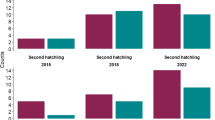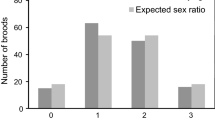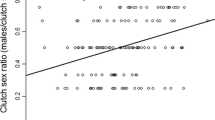Abstract
Variation in the sex ratio at hatching in the chinstrap penguin Pygoscelis antarctica was investigated, using molecular sexing to test predictions of sex allocation theory. The sex ratio was slightly male-biased (0.54) but did not differ significantly from parity. The proportion of males increased with nest size, an estimator of parental quality in chinstrap penguins. High-quality parents were able to produce and rear a higher proportion of male offspring, the more costly sex in this slightly sexually dimorphic species. Our results may be in agreement with Trivers and Willard’s (1973) argument on biases in the offspring sex ratio being contingent on parental condition or quality.

Similar content being viewed by others
References
Ainley DG, LeResche RE, Sladen WJL (1983) Breeding biology of the Adélie penguin. University of California Press, Berkeley
Amat JA, Viñuela J, Ferrer M (1993) Sexing chinstrap penguins (Pygoscelis antarctica) by morphological measurements. Colon Waterbirds 16:213–215
Barbosa A, Moreno J, Potti J, Merino S (1997) Breeding group size, nest position and breeding success in the chinstrap penguin. Polar Biol 18:410–414
Blanco G, Dávila JA, López-Septiem JA, Rodriguez R, Martínez F (2002) Sex-biased initial eggs favours sons in the slightly size-dimorphic scops owl (Otus scops). Biol J Linn Soc 76:1–8
Bradbury RB, Cotton PA, Wright J, Griffiths R (1997) Nestling sex ratio in the European starling Sturnus vulgaris. J Avian Biol 28:255–258
Carrascal LM, Moreno J, Amat JA (1995) Nest maintenance and stone theft in the chinstrap penguin (Pygoscelis antarctica). 2. Effects of breeding group size. Polar Biol 15:541–545
Charnov EL (1982) The theory of sex allocation. Princeton University Press, N J
Dann P, Cullen JM (1990) Survival, patterns of reproduction, and lifetime reproductive output in little blue penguins (Eudyptula minor) on Phillip Island, Victoria, Australia. In: Davis LS, Darby JT (eds) Penguin biology. Academic, New York, pp 63–84
Davis LS, Speirs EAH (1990) Mate choice in penguins. In: Davis LS, Darby JT (eds) Penguin biology. Academic, New York, pp 345–376
Ellegren H (1996) First gene on the avian W chromosome (CHD) provides a tag for universal sexing of non-ratite birds. Proc R Soc Lond B 263:1635–1641
Fargallo JA, León A de, Potti J (2001) Nest maintenance effort and health status in chinstrap penguins, Pygoscelis antarctica: the functional significance of stone provisioning behaviour. Behav Ecol Sociobiol 50:141–150
Gil D, Graves J, Hazon N, Wells A (1999) Male attractiveness and differential testosterone investment in zebra finch eggs. Science 286:126–128
Griffiths R, Tiwari B (1995) Sex of the last wild spix’s macaw. Nature 375:454
Hamilton WD (1967) Extraordinary sex ratios. Science 156:477–488
Hasselquist D, Kempenaers B (2002) Parental care and adaptive brood sex ratio manipulation in birds. Philos Trans R Soc Lond B 357:363–372
Koenig WD, Dickinson JL (1996) Nestling sex ratio variation in western bluebirds. Auk 113:902–910
Komdeur J, Pen I (2002) Adaptive sex allocation in birds: the complexities of linking theory and practice. Philos Trans R Soc Lond B 357:373–380
Krackow S (1995) Potential mechanisms for sex ratio adjustment in mammals and birds. Biol Rev 70:225–241
León A de, Fargallo JA, Moreno J (1998) Parental body size affects meal size in the chinstrap penguin (Pygoscelis antarctica). Polar Biol 19:358–360
Littell RC, Milliken GA, Stroup WW, Wolfinger RD (1996) SAS (R) system for mixed models. SAS Institute, Cary, N.C.
Moreno E, Moreno J, León A de (1999) The effect of nest size on stone gathering behaviour in the chinstrap penguin. Polar Biol 22:90–92
Moreno J, Bustamante J, Viñuela J (1995) Nest maintenance and stone theft in the chinstrap penguin (Pygoscelis antarctica). 1. Sex roles and effects on fitness. Polar Biol 15:533–540
Moreno J, Barbosa A, Potti J, Merino S (1997) The effects of hatching date and parental quality on chick growth and crèching age in the chinstrap penguin Pygoscelis antarctica: a field experiment. Auk 114:47–54
Moreno J, Boto L, Fargallo JA, León A de, Potti J (2001) Absence of extra-pair fertilisations in the chinstrap penguin Pygoscelis antarctica. J Avian Biol 31:580–583
Müller-Schwarze D (1984) The behaviour of penguins. State University of New York Press, Albany
Newton I, Marquiss M (1979) Sex ratio among nestlings of the European sparrowhawk. Am Nat 113:309–315
Palomino JJ, Martín-Vivaldi M, Soler M, Soler JJ (1998) Functional significance of nest size variation in the rufous bush robin Cercotrichas galactotes. Ardea 86:177–185
Plagiani AC, Lee PL, Bradbury RB (1999) Molecular determination of sex ratio in yellowhammer Emberiza citrinella offspring. J Avian Biol 30:239–244
Price T, Kirkpatrick M, Arnold S (1988) Directional selection and the evolution of breeding date in birds. Science 240:798–799
Sheldon BC (1998) Recent studies of avian sex ratios. Heredity 80:397–402
Soler JJ, Møller AP, Soler M (1998) Nest building, sexual selection and parental investment. Evol Ecol 12:427–441
Soler JJ, Neve L de, Martínez JG, Soler M (2001) Nest size affects clutch size and the start of incubation in magpies: an experimental study. Behav Ecol 12:301–307
Spurr EB (1974) Individual differences in the aggressiveness of Adélie penguins. Anim Behav 22:611–616
Stearns SC (1992) The evolution of life histories. Oxford University Press, Oxford
Trivelpiece WZ, Trivelpiece SG (1990) Courtship period of Adélie, gentoo and chinstrap penguins. In: Davis LS, Darby JT (eds) Penguin biology. Academic, New York, pp 113–128
Trivers RL, Willard DE (1973) Natural selection of parental ability to vary the sex ratio of offspring. Science 179:90–92
Viñuela J, Moreno J, Carrascal LM, Sanz JJ, Amat JA, Ferrer M, Belliure J, Cuervo JJ (1996) The effect of hatching date on parental care, chick growth, and chick mortality in the chinstrap penguin Pygoscelis antarctica. J Zool Lond 240:51–58
Walsh D, Metzger A, Higuchi R (1991) Chelex 100 as a medium for simple extraction of DNA for PCR-based typing from forensic material. BioTechniques 10:506–513
Westerdahl H, Bensch S, Hansson B, Hasselquist D, von Schantz T (1997) Sex ratio variation among broods of great reed warblers Acrocephalus arundinaceus. Mol Ecol 6:543–548
Williams TD (1995) The penguins. Oxford University Press, Oxford
Williams TD (1999) Parental and first generation effects of exogenous 17beta-estradiol on reproductive performance of female zebra finches (Taeniopygia guttata). Horm Behav 35:135–143
Acknowledgements
We thank J. Moreno for comments, and the military and scientific staff of the Antarctic Spanish Base “Gabriel de Castilla” for their invaluable support during our stay at Deception Island. Transport to and from the island by the ship of the Spanish Navy “Hespérides” is gratefully acknowledged. This is a contribution to project ANT98-1443-E CICYT. The Spanish Antarctic Research Program C.I.C.Y.T gave permission to work in the study area and for penguin manipulations.
Author information
Authors and Affiliations
Corresponding author
Rights and permissions
About this article
Cite this article
Fargallo, J.A., Dávila, J.A., Potti, J. et al. Nest size and hatchling sex ratio in chinstrap penguins. Polar Biol 27, 339–343 (2004). https://doi.org/10.1007/s00300-004-0596-2
Received:
Accepted:
Published:
Issue Date:
DOI: https://doi.org/10.1007/s00300-004-0596-2




